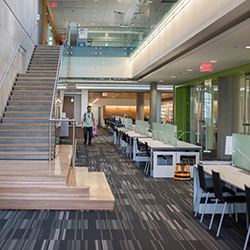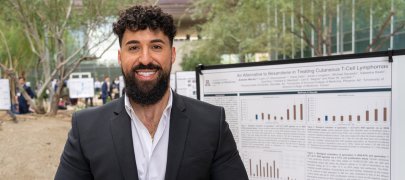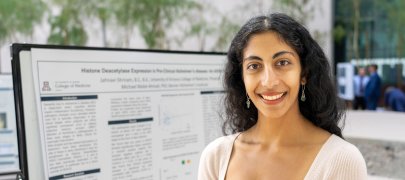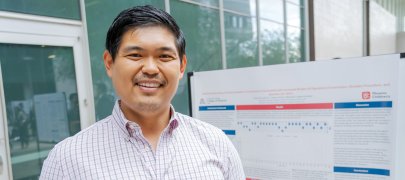
Phoenix Biomedical Campus Library Has Student-Centered Approach

From the inviting white swivel chairs, grouped around a careful arrangement of medical magazines, to the rows of computers and a towering window that invites in the sun and an expansive view of the downtown Phoenix skyscape, the University of Arizona College of Medicine – Phoenix medical library radiates a sense of order and calmness.
Most traditional medical school libraries hold 50,000 to 100,000 print volumes. The Francis A. Countway Library of Medicine, which serves the Harvard Medical School, carries 630,000 print volumes and has access to 3,500 journals.
 But like most new medical schools born in the digital age, the UA College of Medicine library’s focus is on digital offerings and a relatively small print collection. As part of its accreditation, a medical school must provide access to “well-maintained library resources sufficient in breadth of holdings and technology” to support its mission.
But like most new medical schools born in the digital age, the UA College of Medicine library’s focus is on digital offerings and a relatively small print collection. As part of its accreditation, a medical school must provide access to “well-maintained library resources sufficient in breadth of holdings and technology” to support its mission.
The library is a joint-use facility located in the award-winning Health Sciences Education Building. It is designed primarily for the needs of students, staff and faculty of the University of Arizona College of Medicine – Phoenix and Northern Arizona University College of Health and Human Services programs in Phoenix.
David Bickford (pictured above), director of the Phoenix Biomedical Campus Library, said the collection has 1,200 print volumes.
Behind this seemingly low number is an innovative and realistic reason why medical libraries are buying fewer books.
“When medical students say that they want 24/7 access to the library, they don’t mean that they want to get into their favorite medical journal 24/7,” Bickford said. “They already know that they can do that online through the resources that the University of Arizona licenses for them. They want a quiet place to study.”
Some books in high demand by students who prefer a print copy are stocked on the shelves, Bickford said, but a lot of content has shifted to online databases, giving students access to articles 24 hours a day.
As libraries’ content storage has transformed, so has the architectural layout of medical libraries.
 Traditionally, the content shaped the space, Bickford said, but today, the content and the space don’t have much to do with each other.
Traditionally, the content shaped the space, Bickford said, but today, the content and the space don’t have much to do with each other.
“The content is virtual,” he said. “It’s in the Cloud, for the most part. The majority of space is for study and collaboration, and that’s a whole separate set of needs.”
Students on the biomedical campus enjoy a library that is student focused: 80 percent of the space is dedicated to student study and collaboration needs.
Thus, the high-tech study carrels and long row of small group rooms with walls covered in white boards meant for collaboration and group study.
Bickford said medical students have traditional study habits when it comes to libraries.
“They want a quiet environment,” Bickford said. “Our medical students have so much content, understanding the structure and function of the human body, understanding all of the chemistry behind it. They really want a quiet place where they can burrow into their textbooks, into their instructional materials and just memorize intensively so that they can pass their medical licensing exams.”
Media Contact:
Marian Frank
602-827-2022
*Homepage photo courtesy of Horchler Homes
Topics
About the College
Founded in 2007, the University of Arizona College of Medicine – Phoenix inspires and trains exemplary physicians, scientists and leaders to optimize health and health care in Arizona and beyond. By cultivating collaborative research locally and globally, the college accelerates discovery in a number of critical areas — including cancer, stroke, traumatic brain injury and cardiovascular disease. Championed as a student-centric campus, the college has graduated more than 800 physicians, all of whom received exceptional training from nine clinical partners and more than 2,700 diverse faculty members. As the anchor to the Phoenix Bioscience Core, which is projected to have an economic impact of $3.1 billion by 2025, the college prides itself on engaging with the community, fostering education, inclusion, access and advocacy.


